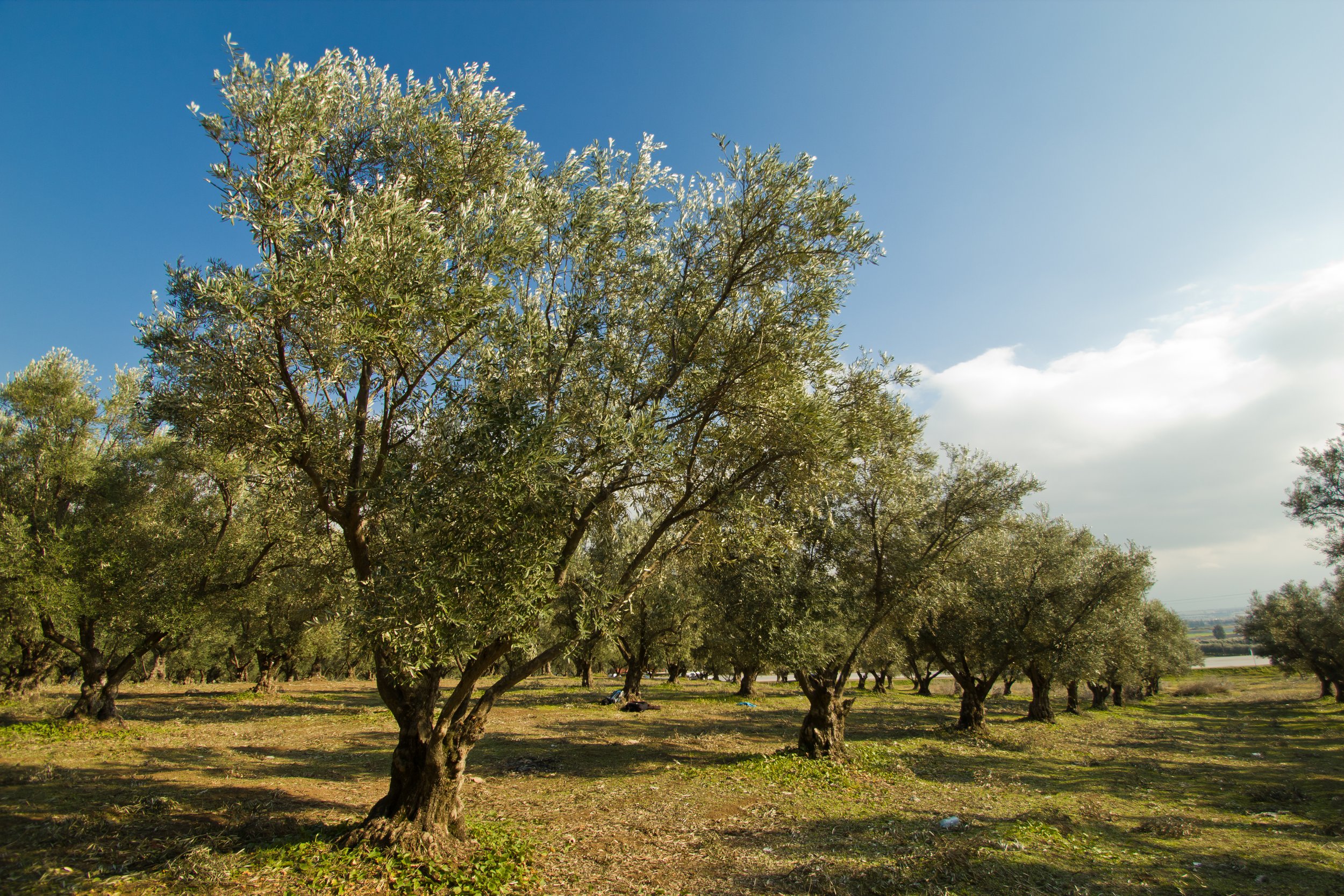
Olive Tree Spacing
Olive planting patterns is a hotly discussed topic. Optimal olive orchard designs involve planting trees to utilize space efficiently and maximize sun exposure. In olive-growing regions around the world, growers have their preferences, but as machine picking and super-high-density orchards become more common, trees must be spaced and pruned specifically for the machine, more than according to local preferences.
There is no exact recipe for tree spacing. It depends on the variety, terrain, climate, proposed harvest method, tree training systems, fertility, irrigation management, and soil conditions. Spacing ranges from as close as 3ft by 12ft (0.9m by 3.7m) to 28ft by 28ft (8.5m by 8.5m) -- also referred to as 28ft on center -- and every combination in between.
For more in-depth information, we recommend the books from G. Steven Sibbett and Louise Ferguson, and from Paul Vossen listed in our Sources below.
SUNLIGHT
The olive tree bears fruit on one-year old wood found on its outer periphery in the presence of adequate sunlight. Olive shoots do not flower and do not produce fruit in full shade. If the trees are planted too closely, shading eventually reduces orchard production. A mature orchard is considered at optimum bearing potential when trees are spaced at the greatest density that still allows them to intercept enough sunlight for annual shoot growth throughout the tree’s periphery.
New olive orchards must produce economic crops as soon as possible. How soon an orchard reaches economic bearing depends on tree density. Before trees reach full size and utilize all allotted space and sunlight, per-acre production is directly related to the number of producing trees. Olive orchards are often planted with filler trees at high densities to use the sunlight most efficiently and reach maximum production before the trees reach full size. Such high-density plantings assume that filler trees are removed as they grow crowded and their shading interferes with production.
TREE SIZE AND SOIL TYPE
The ultimate size of an olive tree is the primary determinant of final tree spacing in a mature orchard. Cultivar and soil largely determine the tree’s ultimate size. For example, among California varieties, Sevillano, Mission, and Ascolano varieties are vigorous and grow to a large size. Manzanillo is a moderately sized tree and requires less space.
All cultivars develop their maximum size on fertile, well-drained soils. Trees on marginal soils do not grow as large. Sites with deep soil, high moisture holding capacity, and high fertility should have trees spaced farther apart than sites with shallower soils, poor water holding capacity, and low fertility or less intensive management.
Trying to keep olive trees of most varieties small with hard pruning results in vigorous shoot growth and poor production, so it is important to keep the size of the adult tree in mind when designing the layout.
TRADITIONAL SPACING
Traditionally, olive trees were planted at a spacing of more than 30ft (7m). This is no longer popular anywhere in the world except for desert dry-farmed regions.
HIGH-DENSITY
These orchards are planted at a high-density of about 200 to 350 trees per acre (494 to 865 per hectare). The more trees planted per acre, the faster the planting comes into bearing. Any variety can work in a high-density setting.
The first decision to be made before selecting a design is whether or not filler trees are to be used to increase tree density and early production. An orchard planted with filler trees begins production sooner and reaches higher production levels than an orchard with standard spacing during the same period. The greater number of trees per acre, however, translates into higher development, managerial, and production costs. Removing the filler trees once the orchard gets crowded is expensive, as is modifying the irrigation after the trees are removed.
Designs For Permanently Set Trees
The most common designs are:
Square: this is the most popular design. Trees are equally spaced within and between rows. This type of orchard is easy to layout and orchard operations can be carried out in both directions. Irrigation drip lines, however, may impede this. It is not generally used when filler trees are planned, as distances between trees and within rows eventually become too small for efficient orchard care.
Offset square: this system is similar to the square design except that trees in adjacent rows are offset. This system is less popular than the square system. It is more difficult to layout and, unless farmed on the diagonal, the rows are closer.
Hexagonal/Equilateral Triangle: this system is similar to the offset square except that distances between trees in any direction are equal. This is only adaptable to plans without filler trees. It allows 17.5% more trees per acre than the square or offset square systems at any given spacing and therefore is more efficient in use of sunlight and land.
Keep in mind that if you are working with uneven terrain, the alignments will gradually slip, so it is necessary to choose which direction will be determinate.
Designs Using Filler Trees
Hedgerow: the hedgerow design places trees closer within rows than between rows. The trees are placed at 8ft x 16ft (2.4m by 4.9m), 9 ft x 18ft (2.7m by 5.5m), or 10 ft by 20ft (3.0m by 6.0m). This allows easy access by equipment, but does not allow efficient use of sunlight as the trees crowd quickly within the rows.
Quincux: in this design, the permanent trees are set in a square pattern with a filler tree in the center of each square. The filler tree being in between rows rather than in the row allows a more efficient use of sunlight. The operational costs may be high, however; the row of filler trees may need a separate irrigation line and access with equipment may be difficult. Unplanted drive rows should be left every 6 to 10 rows to allow access for harvest equipment.
SUPER-HIGH-DENSITY
What three varieties of olives work best in the super-high-density system? The super-high-density system has worked with three varieties: Arbequina, Arbosana, and Koroneiki. Occasionally Tosca is also used. Any other variety closely spaced may have excellent results for the first few years but, eventually, the trees grow too big for their allotted amount of space, grow too tall, and shade the lower portion of the trees. The super-high-density system never allows the trees to exceed a size of about 9 to 10ft tall by 6 to 7ft wide (2.7 to 3.0m by 1.8 to 2.1m) through annual renewal pruning. The trees are planted 5ft by 13ft (1.5m by 4.0m) apart in high vigor sites to 4ft by 12ft (1.2 by 3.6m) apart in low vigor sites. Only highly self-fruitful, precocious varieties will fruit under the conditions of close spacing and heavy pruning. It also helps if the orchard manager can control soil water status to moderate tree vigor. It is anticipated that this system will be more difficult to manage in places with deep soils and high rainfall.
Due to the recent advent of super-high-density planting, many questions still exist as to how this spacing will hold-up over time and what costs will be involved with thinning, if any.
PLANTS PER ACRE TABLE
Below is a rough calculator for density of trees.
SOURCES
G. Steven Sibbett and Louise Ferguson: Olive Production Manual, University of California.
Paul M. Vossen: Organic Olive Production Manual, University of California.

